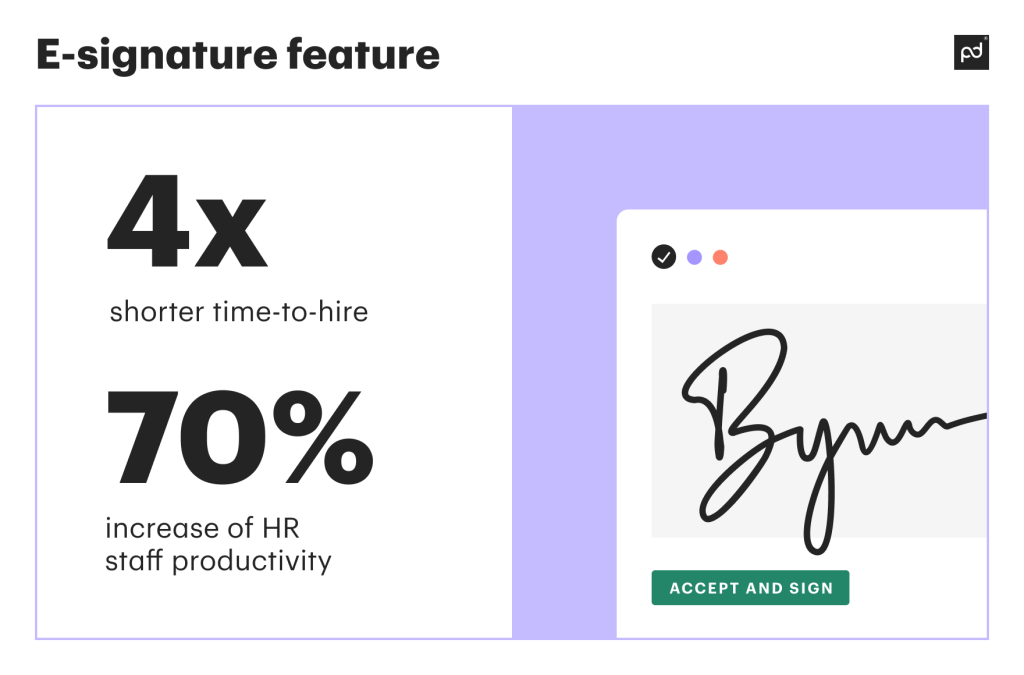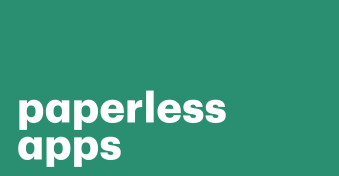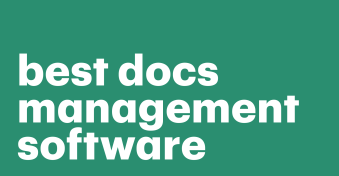Using paper documents within your HR department means your staff has to deal with tons of paper employee records every day.
Such an obsolete approach is a source of huge inefficiency, additional spending, and various unexpected human errors.
The widespread adoption of remote work raises the potential of making paper-based operations worse due to huge delays, delivery flaws, and higher chances of losing any papers within the process.
Moreover, some of the processes are partly or even completely unfeasible in terms of remote candidates and employees.
A transition of your HR department from paper-based to paperless workflows is the way your company can adapt to a new reality.
Let’s find out what the paperless workflow is, how your business can truly benefit from it, define the list of paperless-friendly HR processes, and learn how to save a lot of time and other resources using PandaDoc’s HR automation and Workflows feature.
What is a paperless workflow in HR?
In terms of human resource management, a paperless workflow means the digitizing of various HR processes, eliminating the need for physical paperwork thanks to the widespread usage of electronic documents.
Another essential aspect of the transition to a paperless workflow environment is to optimize existing processes to find and eliminate their flaws — efficiency becomes digitized, and all stakeholders win (including trees!).
PandaDoc has everything for successfully ensuring your HR workflows become paperless. You can start your transition right now.
Scan and recognize your existing paper-based documents.
Use HR templates to create your own homebrew artifacts.
Add e-signatures to hasten your communication with remote candidates and existing employees.
Benefits of a paperless HR department
There are numerous advantages of adopting paperless HR environments over paper-based ones. Below are some of the most notable.
1. Increased processing speed
Each HR department staff member working in a paper-based environment spends hours each week on repetitive tasks that can be automated.
Going paperless can increase your HR department productivity multifold.
The more routine nature a process initially has, the better productivity boost can be achieved.
For example, the Aberdeen Strategy & Research report claims that just a single e-signature feature itself can cause up to 4x shorter time-to-hire, thereby increasing personal HR staff productivity by up to 70%.

All the processes tied with manual data filling have similar hastening opportunities.
2. Fewer workforce is needed
Once your human resource manager can make more within the same period of time, you can reduce the number of personnel yet keep the same level (or better) of team performance.
This means you’ll receive benefits from both fewer salaries and less office space required for allocating and supplying your HR department.
3. No need for massive storage
An average office worker uses an alarming 10,000 sheets of paper each year, as per the US Environmental Protection Agency.
A significant part of these documents must be stored for years after their issue, and the demand for filing cabinets looks just as antiquated an inefficient as it is.
By comparison, digital documents require disproportionately fewer resources for storage.
4. More professional-looking approach
Using the paper-based approach to HR operations may look obsolete for potential employees, especially Gen Z.
This heavily affects the efficiency of hiring: according to a 2022 Greenhouse Candidate Experience Report, about 60% of candidates consider the time-consuming hiring processes (and the paper-based ones are definitely time-consuming) as the trigger for giving up on their current job application and moving on to the next opportunity.
That’s why you should not only act in a modern way but also create a modern impression as your first one to job candidates.
5. Remote-friendly
As we mentioned above, some traditional paper-based approaches make remote hiring nearly impossible.
For potential employees from all over the world who won’t ever visit your office, it’s essential to have an opportunity to draw up and notarize all the documents remotely.
Otherwise, they’ll prefer offers from your more contemporary rivals.
6. Fewer errors
Hours spent each week on manual data entry aren’t just a huge waste of time but also a fertile ground for various human errors.
An automatic data population and transferring system leave far less room for such errors occurring.
PandaDoc for HR will help you out.
Using free templates is a way to form a glossy-looking document from the very beginning and in just a few minutes.
Add your content pieces and customized templates into your personal content library, and then reuse them at any moment.
This way you’ll effectively reuse your content many times instead of having to generate new paperwork each time.
7. Saving the trees
We highlighted this above as well.
Ecological friendliness is definitely an important benefit!
With digital document management software, you don’t need to buy huge amounts of copy paper each month.
Taking into account the fact that such paper is almost always made of 100% non-recycled cellulose, the positive environmental impact of going paperless cannot be overemphasized.
8. Higher security
There are two main factors in how the paperless approach affects security.
First of all, it’s extremely challenging and costly to set role-based access within the paper-based workflow.
Second, in a huge pile of paper-based documents, it’s generally only a matter of time before something important will be lost.
And virtually anyone can then access these lost documents. When using a document management system, both these concerns are nonexistent.
And there is much more to say here. Many software tools you can use for making your HR department paperless are compatible with popular security standards.
For example, PandaDoc offers secure cloud storage fully compliant with HIPAA, FERPA, and GDPR, coupled with a secure sharing option.
9. Paperless-friendly HR processes
The list of HR processes that can become paperless with ease is wide.
We’ve created a table for you to conveniently review. For each process, we’ve added a list of related HR documents.
| Process name | Documents related | Benefits of going paperless |
|---|---|---|
| Recruitment | Job descriptions Job advertisements Candidate resumes and cover letters Candidate application forms Reference checks and background check reports Assessment tests and interview evaluations Employment offer letters |
Faster time-to-hire Higher retention Lower costs Higher security Faster document access |
| Onboarding |
Employee contract/agreement Employee handbook or policies manual Confidentiality or non-disclosure agreements Tax and social security forms (e.g., W-4 or W-9 forms in the US) Direct deposit authorization form Emergency contact information Benefit enrollment forms Proof of identity and work eligibility (e.g., passport, driver’s license, social security card) Onboarding checklists and orientation schedules |
Lower employee churn Faster processes Higher employee tenure Higher satisfaction and motivation Lower costs Faster document access |
| Payroll | Employee payroll records Timesheets or time cards Payroll registers and summary reports Payroll tax forms and filings (e.g., Form 941 in the US) Year-end tax documents (e.g., W-2 or 1099 forms in the US)Payroll deduction authorizations (e.g., for retirement plans, insurance premiums, or garnishments) Compensation and salary change forms |
Higher satisfaction Faster processes Fewer financial errors Lower costs Faster document access |
| Time tracking | Time and attendance records Leave request forms (e.g., for vacation, sick leave, or personal time off) Leave balance reports Overtime approval forms |
Better performance tracking Faster processes Higher employee satisfaction Lower costs Faster document access |
| Education |
Employee training records and certifications Training materials and handouts Course outlines and schedules Training evaluations and feedback forms |
Better staff performance Faster processes Higher satisfaction and motivation Lower costs Faster document access |
| Offboarding |
Employee resignation or termination letters Exit interview forms and summaries Final pay and benefits calculations Equipment and access return checklists Confidentiality and non-compete reminders COBRA (Consolidated Omnibus Budget Reconciliation Act) continuation coverage notices, if applicable in the USTermination or separation paperwork as required by law or company policy |
Faster and smoother offboarding Better company reputation Lower costs Fewer complaints Faster document access |
Making your HR department paperless with PandaDoc
To wrap up, let’s take a look at the steps required for switching your HR department to a paperless one with the help of PandaDoc software.
1. Examine your processes
The first step is aimed at evaluating your current HR processes and identifying which areas can be digitized.
2. Form a plan
Next, you should set goals and detail the strategy you’ll use for your transition.
3. Choose the right technology
HR is a combination of various activities; likewise, there are many different software solutions covering them.
You may choose a particular suite for each or rely on a complex solution.
PandaDoc has everything you need in one place to make your HR department paperless and automated.
4. Set up the software
This step is about implementing the technological solution you’ve selected.
PandaDoc offers a smooth launch process described in detail for your convenience. Don’t forget to set the roles and permissions.
5. Digitize existing documents
Scan, convert, and organize all existing paper records into digital formats.
PandaDoc offers conversion features for scanned and uploaded documents into editable forms: PDF-to-Word, PDF-to-Excel, and Word-to-PDF.
In addition, you can order onboarding services containing content migration.
For any new HR document creation purposes, it’s better to use one of the 750+ free templates PandaDoc offers.
6. Automate your HR processes
Leverage HR technology to automate processes — recruitment, onboarding, payroll, time tracking, and performance management.
PandaDoc has several automation features aimed at different goals. You can read more about them here and here.
7. Enable the e-signature feature
PandaDoc has a free e-signature option available from the very start.
8. Train and motivate your employees
Ensure that everyone understands how to use the new digital files, systems, and tools effectively. You should also encourage them to adopt paperless practices in their daily work.
You can also find a wealth of valuable information about efficient PandaDoc usage for leveraging your HR activities by following this link.
Want to know more about how PandaDoc for HR can be helpful for your human resource department? Schedule a demo now!
Disclaimer
Parties other than PandaDoc may provide products, services, recommendations, or views on PandaDoc’s site (“Third Party Materials”). PandaDoc is not responsible for examining or evaluating such Third Party Materials, and does not provide any warranties relating to the Third Party Materials. Links to such Third Party Materials are for your convenience and does not constitute an endorsement of such Third Party Materials.


